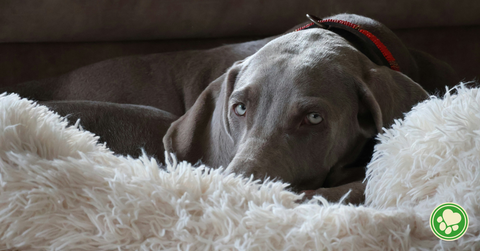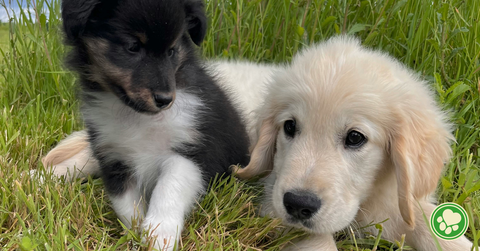Understanding Bloat in Dogs
11 . August .2025Katy van suilchem0 Comments
The best way to protect our furry friends is to be as clued up as we possibly can about their health. That’s why we wanted to touch upon a serious condition that affects dogs, called Gastric Dilation-Volvulus, or, as it’s more commonly known, bloat.
Bloat can be life-threatening and a really scary prospect for dog owners. But by understanding the risks, symptoms, prevention strategies, and what to do in an emergency, you can give your dog the best possible chance of recovery.
What is GDV?
GDV stands for Gastric Dilation-Volvulus, and it happens when the stomach fills with gas and twists upon itself, trapping the gas and potentially cutting off blood supply to essential organs. This twisting restricts blood flow, causing the stomach tissue to die and potentially rupture. It also compresses major blood vessels, leading to shock and hindering a dog’s ability to breathe.
This is not the same as everyday bloating; GDV is a medical emergency that needs immediate treatment.
Dog Breeds Susceptible to Bloat
Bloat is most commonly seen in large and giant dog breeds. Because of their body shape, there is more room for the stomach to expand and move around, increasing the chance of it twisting.
High-Risk Breeds Include:
- Great Danes
- Irish Wolfhounds
- Standard Poodles
- German Shepherds
- Weimaraners
- Irish Setters
- Akitas
- Boxers
- St. Bernards
- Doberman Pinschers
- Bloodhounds
- Basset Hounds
Age and Genetics
Research shows that the risk of bloat increases with age. Studies have shown that for large breeds, the risk goes up by 20% each year after the age of 5, and for giant breeds, 20% per year after age 3. This increased risk is thought to stem from age-related changes, such as weaker ligaments in the stomach or a slower, less efficient digestive system.
While no single “bloat gene” has been identified, genetics also play a major role. Dogs with a first-degree relative (parent or sibling) who has had bloat are 63% more likely to develop the condition themselves. Due to this heightened risk, dogs that have experienced bloat in the past, or those whose siblings or parents are known to have suffered from bloat, are generally not recommended for breeding.
Being aware of whether or not your dog falls into a high-risk group can help you take steps to reduce the risks. However, while some breeds are more susceptible than others, it’s crucial to remember that any dog can develop bloat, regardless of size or breed.
Knowing the Signs
Early Signs of Bloat:
- Attempting to vomit but nothing comes out
- Swollen, hard abdomen
- Restlessness or pacing
- Lethargy or weakness
Advanced Signs of Bloat:
- Pale gums
- Excessive drooling
- Signs of abdominal pain (whining, arching back into the “prayer” position)
- Rapid breathing or panting
- Collapse
Act Fast: Bloat progresses very quickly. If you notice any of these signs, take your pet to a vet as soon as possible.
How Do Vets Treat GDV?
It’s worth having a general understanding of how vets treat bloat, should it occur.
- Stabilisation. Your dog will work quickly to stabilise your dog using IV fluids, oxygen support, and pain relief.
- Decompression. A tube may be passed through the mouth to release gas, or if this fails, the vet may insert a needle through the skin to allow gas to escape (trocarisation).
- Emergency Surgery (Gastropexy). Once stabilised, emergency surgery may be needed to untwist the stomach, remove any damaged tissue, and tack the stomach in place to prevent future twisting.
Recovery generally depends on how quickly the dog was treated and the extent of the damage. However, most dogs do very well with prompt surgery and good aftercare. They might stay at the clinic for a few days, on fluids, antibiotics, and careful monitoring.
Reducing the Risk
There’s no sure-fire way to eliminate the risk of bloat completely, but there are some things you can do at home to reduce it, especially if your dog is in one of the high-risk categories we mentioned earlier.
- Feed smaller, more frequent meals. One advantage of cold-pressed food is that it allows for lighter, more efficient feeding, reducing the load on the stomach. Breaking meals into smaller portions helps prevent the stomach from becoming too full, reducing the risk of gas build-up and stomach twisting.
- Use slow feeders or puzzle bowls. These help prevent your dog from eating too quickly. Eating slowly reduces the amount of air swallowed during meals, which again reduces the risk of bloat.
- Limit exercise around meals. Allow plenty of time for digestion, preferably at least an hour or two between meals and exercise.
- Prioritise weight management. Keep your dog at a healthy weight by feeding them quality, nutritious food, ensuring regular exercise and staying on top of vet appointments.
While genetics do play a role, even small lifestyle changes can make a big difference.
What to Do in an Emergency
If you suspect your dog is suffering from Gastric Dilation-Volvulus (GDV), time is critical.
- Keep calm. It’s a scary situation, but your dog needs you focused and composed. Try to avoid adding unnecessary stress for yourself, your dog, or those around you.
- Call your vet or emergency vet clinic immediately. Describe the symptoms in detail and let them know you suspect bloat. Many clinics will start preparing for the emergency survey while you’re en route.
- Take your dog to the vet straight away. Don’t wait to see if the symptoms ease on their own at home. Time is critical, so get to the vet as soon as possible.
- Do NOT attempt home remedies or try to induce vomiting. Taking matters into your own hands can make the condition worse and delay lifesaving treatment.
- Trust your instincts. You know your dog better than anyone. If something feels seriously wrong, trust your gut. Even if it turns out to be a false alarm, it’s always safest to act quickly.
Cobbydog’s Commitment
At Cobbydog, we make cold-pressed dog food that’s gently prepared and easy to digest. Unlike traditional kibble, our cold-pressed food doesn’t swell in the stomach. Instead, it breaks down from the outside in, quickly and naturally. This helps reduce gas build-up and pressure inside the stomach, two factors that can contribute to bloat.
Because our food is packed with nutrients, you can feed smaller portions less often, putting less strain on your dog’s digestive system. It’s a great choice for dogs with sensitive stomachs, or those at higher risk of GDV due to their breed, size, age, or family history.
While no food can eliminate the risk of bloat entirely, choosing a high-quality, easy-to-digest diet like cold-pressed is a smart step towards keeping your pup happy, healthy, and safe.
Explore our Cold-Pressed range or contact our team by calling 01535 681927 or emailing cobbydog@cobbydog.com; we’re always happy to help.
For more information about Gastric Dilation-Volvulus, speak to your vet, or see the following resources:
- Bloat (swollen belly) in dogs - PDSA
- Bloat in Dogs | Symptoms and Treatment of Bloat | Blue Cross
- Bloat in Dogs | PetMD








